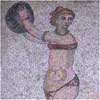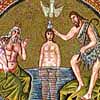 Text search Text search
 Related images Related images
 HistoryWorld HistoryWorld
 Link Link
 Map Map
Click the icons to visit linked content. Hover to see the search terms. |
|  |
| | | | | | | |
|
| c. 100 |
| | | Sculptors in the Roman empire develop the most brutally realistic convention in the history of portraiture | | 
| |
|
| c. 165 |
| | | The bronze equestrian statue of Marcus Aurelius, on the Capitol in Rome, begins a long European tradition of public sculpture | |   
|  | Marcus Aurelius, equestrian statue, 2nd century AD
Fotofile CG
|
|
|
| c. 250 |
| | | The Christians of Rome use the catacombs as tomb chambers, and decorate the walls with murals on New Testament themes | |  
| |
|
| c. 320 |
| | | Roman mosaic is at its most lavish in the floors of Piazza Armerina, in central Sicily | |  
|  | Piazza Armerina, Sicily
Fotofile CG
|
|
|
| c. 390 |
| | | The church of Santa Pudenziana in Rome begins the great tradition of Christian mosaics | |  
| |
|
| c. 460 |
| | | The mausoleum of Galla Placidia begins Ravenna's great tradition of Christian mosaic | |    
|  | Ravenna, mosaic in Neon Baptistery
Fotofile CG
|
|
|
| 547 |
| | | Justinian and Theodora, each with a retinue of attendants, face each other in mosaic from the walls of San Vitale in Ravenna | |    
| |
|
| c. 1200 |
| | | In the cathedral on Torcello, and in St Mark's, Venetian mosaics are a culmination in the west of the Byzantine tradition | |    
| |
|
| 1259 |
| | | Nicola Pisano completes a pulpit for Pisa, borrowing details from Roman sarcophagi - an early example of a new interest in the classical past | |  
| |
|
| c. 1305 |
| | | Enrico degli Scrovegni employs Giotto to paint the cycle of frescoes in his chapel in Padua | |    
| |
|
| | | | | |
| |